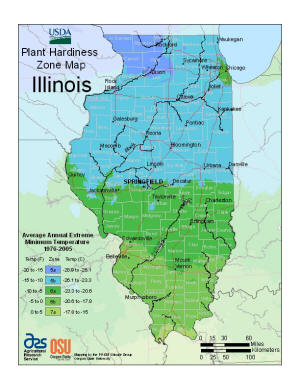|
 New zone map, starting seeds, Allen Garden Day New zone map, starting seeds, Allen Garden Day
By John
Fulton
 Send a link to a friend
Send a link to a friend
[March 01, 2012]
There has been quite a bit in the
popular press about the USDA changing the Hardiness Zone Map due to
the "global warming" phenomenon. These hardiness zones are used to
select perennial plants for use in your landscape plan. For the
Logan County and Menard County areas, we are still in the 5b zone.
The Sangamon County area is now split, with Springfield being the
border for zone 5b and zone 6a. The zone has shifted, with the
border in our area now being between 5b and 6a, instead of 5a and
5b.
|
 While much has been made of the changes, long-term selection of
perennials has a simple rule of thumb: "better safe than sorry."
This simply means if you live in a border area, you should
probably select the zone to your north to be on the safe side.
Zone 6a plants may survive well, but that abnormal winter will
send them to plant heaven. There are also the new zone numbers
to deal with, since many of the zones are now divided; whereas
before, zone 5 was the predominant division. While much has been made of the changes, long-term selection of
perennials has a simple rule of thumb: "better safe than sorry."
This simply means if you live in a border area, you should
probably select the zone to your north to be on the safe side.
Zone 6a plants may survive well, but that abnormal winter will
send them to plant heaven. There are also the new zone numbers
to deal with, since many of the zones are now divided; whereas
before, zone 5 was the predominant division.Starting seeds
It's now approaching early March. Although winter may still
be with us, it is time to plan for starting your own
transplants. There are quite a few details to begin your own
transplants. Starting your own will only pay benefits for you if
you want to transplant several plants; otherwise, the seed cost
(and it has gone up this year) may be more than a four-pack of
plants. Of course, some people just enjoy raising their own from
seed, or you do it to make sure you get a variety you want.

I'll begin with the hardiness zone. All of Logan County lies
in zone 5b, but we are on the border with 6a now. What
difference does this make? "It makes about three weeks'
difference in seed starting date" is the answer. In zone 5b, we
would want to start broccoli, cabbage, cauliflower and lettuce
(if that's something you want to transplant) as early as March
5. Eggplant, herbs, pepper and tomato would be started about
March 25. Cucumber, muskmelon and watermelon are started as
early as April 15. The rule of thumb is to allow about six weeks
before you want to set the plants outside.
You should use a sterile growing medium to start seeds in.
Several kinds of soilless germinating mixes, potting soils, peat
cubes and compressed peat pellets are available. These media are
generally free from insects, diseases and weeds. Enough
fertilizer is generally present in these to allow for three or
four weeks of plant growth.
As far as sowing the seeds, traditionally seeds have been put
in shallow boxes in rows about 2 inches apart and covered
lightly with vermiculite. Soon after the seeds come up, they are
transplanted into other containers. An easier method is to start
the seeds directly in the final growing container. For small
individual or sectioned containers, it is common to plant two
seeds per section. The final container should match the seed (or
plant) planting depth to what it would be directly seeded in a
garden.
Most seeds will germinate in a growing medium temperature of
60 to 70 degrees, but the melons and eggplants like it a bit
warmer. Watering and fertilizing are just as important as
seeding directly into a garden. Water can't be too much or too
little. The medium you are using also makes a difference, as
peat pellets tend to dry out quickly. Fertilizer should be in
the medium for the first three to four weeks. You can add a
soluble fertilizer to the water at the rate of one tablespoon
per gallon, to be used about once a week on established
seedlings. Nonfertilized water should be used between the
fertilizer applications.
[to top of second column] |

Vegetable plants need direct light. Natural light only goes so far
in the winter months. We want to try to provide about 12 hours of
light a day on these transplants. Artificial lights work well to
supplement natural light, or provide all light in a basement
setting. Grow light bulbs work well but are expensive. A combination
of cool white fluorescents and incandescent bulbs provides about the
same light spectrum. Lamps should be about 12 inches away from plant
leaves.
Before your starts are transplanted outdoors, they should be
hardened gradually by exposing them to outside conditions. Start by
placing the plants outside a few hours a day. Use a very sheltered
area to protect from direct light and winds. Gradually extend the
time outdoors as planting time approaches. Remember, this process
takes at least six weeks, so don't wait until the week before you
are ready for transplants. Otherwise, you'll be standing in line
buying your plants.
Russel Allen Garden Day
Russel Allen was one of the people in the original Master
Gardener group in Logan County. Russel always joked he was the
"worst Master Gardener," but he was passionate about gardening and
the program. In his memory, the Logan County Master Gardeners will
have a Russel Allen Garden Day on Saturday, March 10, at Lincoln
College, from 9-1. Cost is $10 for preregistration and $12 at the
door, and registration materials are available at the Extension
office or
online.
[By
JOHN FULTON,
University of Illinois Extension]


 |